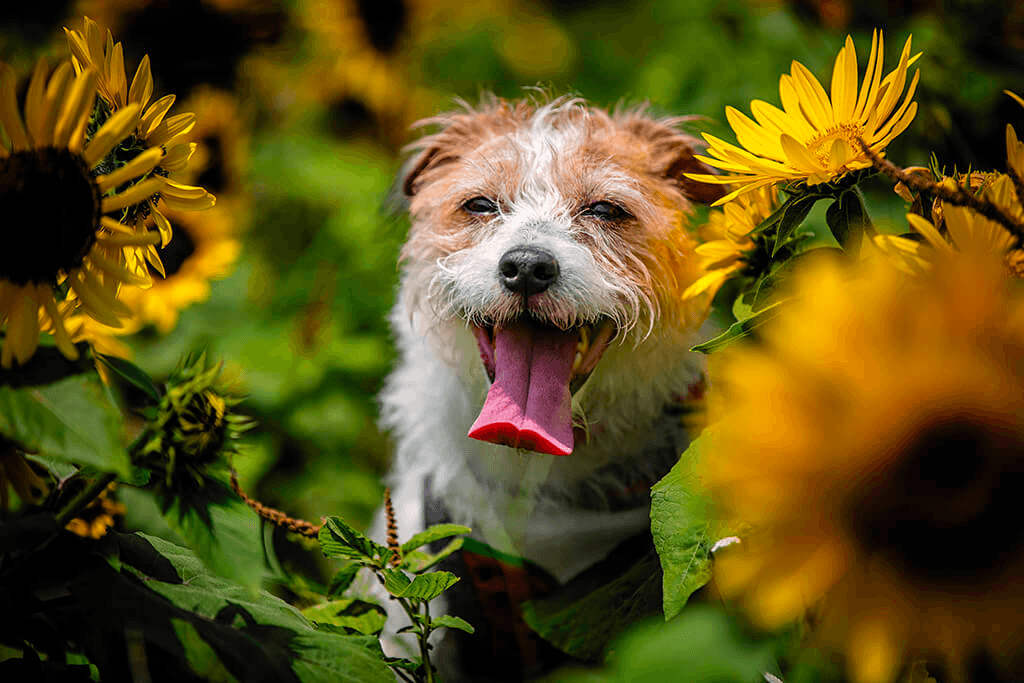At certain times of the year, spring allergies (a.k.a. “hay fever”) are in full swing for people. But what about our four-legged companions? Are they affected by the same seasonal allergens that we are? More specifically, can dogs be allergic to pollen?
In this article, we are going to discuss whether or not dogs can be allergic to pollen, what the signs of a pollen allergy are in dogs, and whether different types of pollen are more likely to cause allergy symptoms. We’ll also cover how you can work with your veterinarian to manage your dog’s pollen allergies.
Can Dogs Have Pollen Allergies?
We all know how inconvenient and irritating allergies can be for us, but did you know that they can be just as troublesome for your four-legged companions?
Dogs can be allergic to various things found in their environment, one of the most common being pollen produced by grasses, trees, and weeds.
There are many types of pollen, and their levels vary by season and region. However, the majority of pollen is produced in the spring (March through May) and fall (September through November), which is why allergy-prone or allergic dogs tend to exhibit signs during these specific times.
There is also a genetic component to allergy development in dogs. Some breeds are more likely to be triggered by exposure to pollen. Dog breeds that may be more prone to pollen allergies include:
- Boxers
- Cocker Spaniels
- English Bulldogs
- French Bulldogs
- German Shepherds
- Golden Retrievers
- Labrador Retrievers
- Pit Bull Terriers
- West Highland White Terriers
However, it should be noted that pollen allergies, and allergies in general, are fairly common in all breeds of dogs. Dogs generally exhibit signs of allergies after 6 months of age, with most affected dogs being over 1 or 2 years of age.
Signs of Pollen Allergies in Dogs
As stated previously, pollen allergies in dogs occur most commonly in the spring and fall seasons. The most common sign in dogs is itchy skin. This discomfort can be localized to one area of the body, like the paws, or more generalized (all over the body). However, some dogs will even exhibit signs of gastrointestinal disturbances in response to seasonal pollen.
Let’s break down some of the more common symptoms of pollen allergies that we see in dogs:
Skin-Related Signs
- Skin irritation
- Occasional scratching, licking, or chewing of skin
- Paw discomfort
- Face rubbing
- Changes in skin and coat
- Increased shedding
- “Scooting” or licking the rear-end
Respiratory-Related Signs
- Irritated or runny eyes
- Runny nose
- Coughing
- Wheezing
- Snoring
Gastrointestinal-Related Signs
- Upset stomach
So, as you can see, the majority of symptoms of pollen allergies in dogs are related to issues with their skin. In fact, the most common areas of your dog’s body that are affected by pollen allergies are the paws (especially between their toes), limbs, around their eyes and mouth, ears, armpits, belly and groin, and tail.
If you note any of the above signs, it is strongly recommended that you schedule an exam with your veterinarian. Early intervention is key in the management of pollen allergies in dogs!
Pollen Allergies Vs. Other Allergies in Dogs
A large number of substances can be allergy triggers for dogs. Some of the most common allergens are pollen, mold spores, dust mites, and flea saliva.
As stated previously, the majority of pollen is produced during the spring and fall seasons. So, it makes sense that the symptoms of pollen allergies in your four-legged companions are most often seen during these times. Unfortunately, many of the previously mentioned allergens can cause similar signs. So, how do you know if pollen allergies are the cause of your dog’s discomfort during the spring and fall seasons?
Pollen allergies are diagnosed based on your dog’s specific symptoms, physical exam findings, and a history of having recurring symptoms during the same seasons every single year.
Your veterinarian will rule out other causes of allergies, such as fleas. They may also perform a diagnostic skin scrape to rule out external skin mites as the cause of your dog’s signs. A diet trial may be necessary to eliminate the possibility of an underlying food allergy.
Diagnosing Pollen Allergies in Dogs
The “gold standard” for diagnosing pollen allergies is an intradermal skin test. This is generally performed by a veterinary dermatologist. To perform an intradermal skin test, a small area of your dog’s fur (on their side) is shaved, and their skin is injected with very small amounts of several different allergens that are common for the region in which they live. A customized treatment plan can then be created based on the degree of your dog’s skin reaction to the test allergens.
While not as accurate as intradermal skin testing, your veterinarian might also recommend blood allergy testing. This type of testing looks for antibodies to various regional allergens in a sample of your dog’s blood. It can serve as an additional method to narrow down which allergens, and specifically pollen allergens, your dog should try to avoid.
How to Help a Dog With Pollen Allergies
Whether you’re a dog or a human, dealing with the symptoms of pollen allergies can be annoying, frustrating, and downright uncomfortable. Thankfully, many ways are available to manage pollen allergies in dogs successfully.
Keep in mind that pollen allergies in dogs can be MANAGED but not cured. So, it is always best to work with your veterinarian to develop a personalized plan that will benefit your dog the most during pollen allergy season.
The following are some of the current recommendations for the management of dog pollen allergy signs:
Anti-Itch Medications: There are several different classes of prescription anti-itch medications that your veterinarian may prescribe for your dog’s pollen allergies, including Apoquel, Zenrelia, Cytopoint, and Atopica. Each of these medications works differently to decrease current itchiness and also manage itchiness during flare-ups of pollen allergies.
Antihistamines: Over-the-counter antihistamines such as Benadryl (diphenhydramine) or Zyrtec (cetirizine) might help to reduce some of your dog’s pollen allergy symptoms IF they are mild. However, more severe cases may require prescription allergy medications. Regardless, you should always consult your veterinarian BEFORE giving any medications.
Immunotherapy: Immunotherapy, also referred to as dog allergy shots, identifies the specific allergens affecting your dog and then utilizes injections or oral (by mouth) drops to desensitize your pet to those particular allergens over time. This should result in reduced allergy symptoms. After desensitization has been achieved, these injections or oral drops are usually given indefinitely at a maintenance dose.
Nutrition: Certain therapeutic dog foods are formulated to aid in managing your dog’s itching and skin inflammation due to food sensitivities and pollen allergies. These diets often contain novel or hydrolyzed protein sources as well as ingredients to support your dog’s skin barrier and reduce itching.
Novel protein is a protein source not typically seen in your pet’s diet and may include things like rabbit or duck. Hydrolyzed protein is broken down into very small pieces to avoid detection by your pet’s immune system.
Be sure to consult your veterinarian to see if there are nutritional options for your dog’s pollen allergies. If a therapeutic diet is recommended by your veterinarian, make sure to properly transition your dog’s food to avoid gastrointestinal issues.
Steroids: Your veterinarian might prescribe steroid medications such as prednisone and prednisolone (to reduce inflammation of your dog’s skin) for the short-term management of severe allergy cases. However, due to the serious short- and long-term side effects of steroids, your veterinarian will most likely transition your dog to one of the previously mentioned prescription anti-itch medications for long-term use in your dog.
Topical Therapy: Topical products such as medicated shampoos, leave-on mousse, sprays, ointments, and wipes can all be used to manage your dog’s pollen allergies by physically reducing the amount of pollen allergens on your dog’s skin and coat and by soothing discomfort. Consult with your veterinarian to determine which topical option would work best for your dog based on their specific allergy symptoms and current skin condition.
Other Ways to Help
- Wipe your dog down. Wipe your dog’s belly, paws, and legs after being outdoors during high-pollen times. This can help physically reduce the amount of allergens on your dog’s skin.
- Bathe your dog more frequently. Regular bathing, as often as weekly to every 2-4 weeks, with aloe-oatmeal shampoo for pets, can also help reduce the amount of pollen on your dog’s skin and coat. Be sure to use lukewarm water, as hot water can cause further discomfort. Lather and allow your dog to soak for 10-15 minutes before rinsing thoroughly.
- Wash your dog’s bedding more often. Be sure to also wash all of your dog’s bedding more frequently to minimize the accumulation of pollen allergens on surfaces that they come into contact with regularly.
- Use air filters in your home to help trap pollen. Since it is impossible to eliminate your dog’s exposure to pollen allergens, using a high-quality HEPA filter can reduce the amount of pollen in your home.
Conclusion
As we have discussed in this article, pollen allergies in dogs are common. Pollen from grasses, trees, and weeds are some of the most common causes of allergy signs in our four-legged companions.
It is important to note that there is NO CURE for pollen allergies in dogs. And, while treating pollen allergies in your dog can be frustrating, there are many options available to help manage their symptoms and keep them comfortable.
It is best to work closely with your veterinarian to develop a multimodal approach to managing your dog’s pollen allergies that focuses on strengthening the skin barrier, maintaining a healthy immune response, and managing itchiness. It may take some trial and error to determine the most effective approach for your pet, but doing so can keep them happy and healthy and enjoying life and all of its seasons to the fullest!
Sources:
https://www.petmd.com/dog/conditions/skin/seasonal-allergies-dogs
https://vcahospitals.com/shop/articles/frustrated-by-seasonal-allergies
https://www.hillspet.com/dog-care/healthcare/managing-dog-seasonal-allergies?lightboxfired=true#
https://www.petmd.com/dog/conditions/systemic/pollen-allergies-dogs
https://vcahospitals.com/know-your-pet/allergy-general-in-dogs






